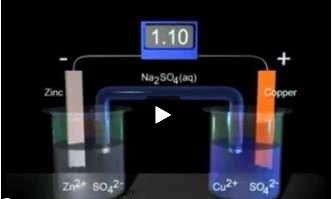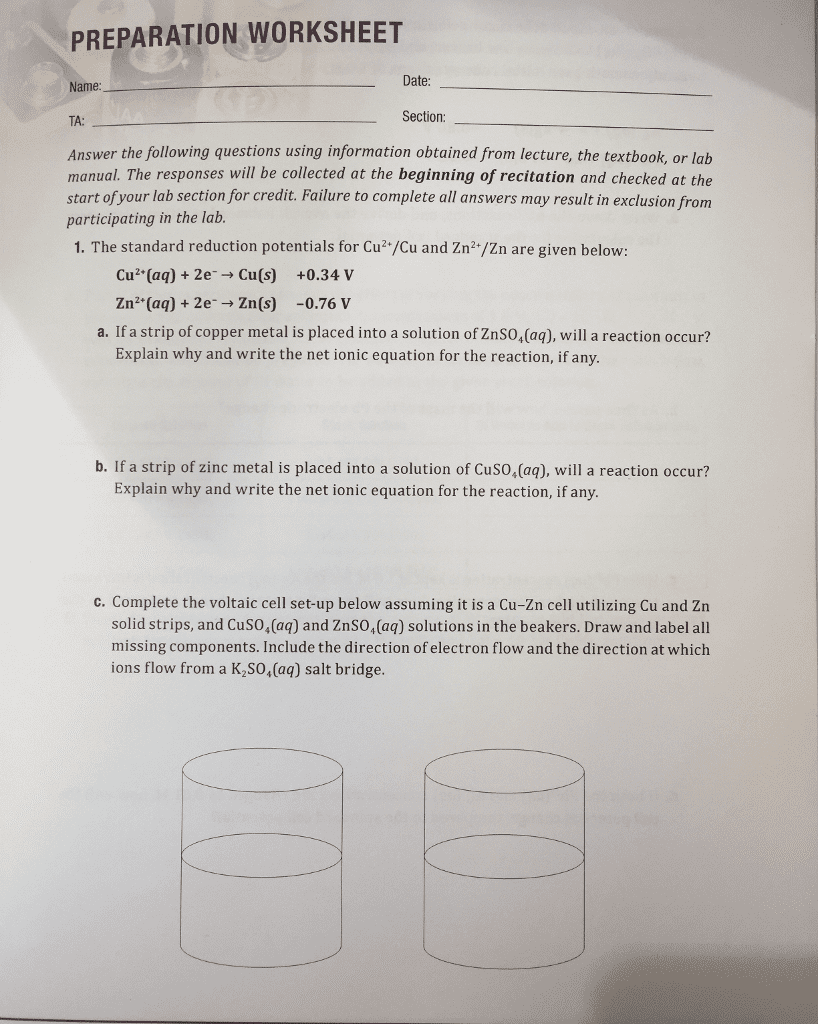What are the similarities and differences between Figure 20.3 and Figure 20.4? (b) Why are Na+ ions drawn into the cathode half-cell as the voltaic cell shown in Figure 20.5 operates?
One Class Solution:-
Figure 20.3 shows spontaneous reaction when a strip of zinc is placed in contact with a Cu2+ solution. Cu2+(aq) ions fades and copper metal deposits on the zinc. At the same time, the zinc begins to dissolve.
Same redox reaction: Cu2+(aq) +Zn → Cu +Zn2(aq)+ is occurs in both cases (Figure 20.3 and 20.4). The significant difference between Figure 20.3 and 20.4 is that in the voltaic cell the Zn metal and Cu2+(aq) are not in direct contact with each other. Zn metal is in contact with Zn2+(aq) in one compartment, and Cu metal is in contact with Cu2+(aq) in the other compartment. Cu2+(aq) reduction can occur only by the flow of electrons through an external circuit, namely, a wire connecting the Zn and Cu strips. Electrons flowing through a wire and ions moving in solution both constitute an electrical current.
In Figure 20.5, a salt bridge serves this purpose. The salt bridge consists of a U-shaped tube containing NaNO3(aq), whose ions will not react with other ions in the voltaic cell or with the electrodes. The electrolyte is often incorporated into a paste or gel so that the electrolyte solution does not pour out when the U-tube is inverted. As oxidation and reduction proceed at the electrodes, ions from the salt bridge migrate into the two half-cells—cations migrating to the cathode half-cell and anions migrating to the anode half-cell—to neutralize charge in the half-cell solutions. Whichever device is used to allow ions to migrate between half-cells, anions always migrate toward the anode and cations toward the cathode.
What are the similarities and differences between Figure 20.3 and Figure 20.4? (b) Why are Na+ ions drawn into the cathode half-cell as the voltaic cell shown in Figure 20.5 operates?
One Class Solution:-
Figure 20.3 shows spontaneous reaction when a strip of zinc is placed in contact with a Cu2+ solution. Cu2+(aq) ions fades and copper metal deposits on the zinc. At the same time, the zinc begins to dissolve.
Same redox reaction: Cu2+(aq) +Zn → Cu +Zn2(aq)+ is occurs in both cases (Figure 20.3 and 20.4). The significant difference between Figure 20.3 and 20.4 is that in the voltaic cell the Zn metal and Cu2+(aq) are not in direct contact with each other. Zn metal is in contact with Zn2+(aq) in one compartment, and Cu metal is in contact with Cu2+(aq) in the other compartment. Cu2+(aq) reduction can occur only by the flow of electrons through an external circuit, namely, a wire connecting the Zn and Cu strips. Electrons flowing through a wire and ions moving in solution both constitute an electrical current.
In Figure 20.5, a salt bridge serves this purpose. The salt bridge consists of a U-shaped tube containing NaNO3(aq), whose ions will not react with other ions in the voltaic cell or with the electrodes. The electrolyte is often incorporated into a paste or gel so that the electrolyte solution does not pour out when the U-tube is inverted. As oxidation and reduction proceed at the electrodes, ions from the salt bridge migrate into the two half-cells—cations migrating to the cathode half-cell and anions migrating to the anode half-cell—to neutralize charge in the half-cell solutions. Whichever device is used to allow ions to migrate between half-cells, anions always migrate toward the anode and cations toward the cathode.


